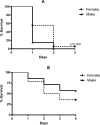Two murine models of sepsis: immunopathological differences between the sexes-possible role of TGFβ1 in female resistance to endotoxemia
- PMID: 37875957
- PMCID: PMC10594922
- DOI: 10.1186/s40659-023-00469-8
Two murine models of sepsis: immunopathological differences between the sexes-possible role of TGFβ1 in female resistance to endotoxemia
Abstract
Endotoxic shock (ExSh) and cecal ligature and puncture (CLP) are models that induce sepsis. In this work, we investigated early immunologic and histopathologic changes induced by ExSh or CLP models in female and male mice. Remarkable results showed that females supported twice the LD100 of LPS for males, CLP survival and CFU counts were similar between genders, high circulating LPS levels in ExSh mice and low levels of IgM anti-LPS in males. In the serum of ExSh males, TNF and IL-6 increased in the first 6 h, in CLP males at 12 h. In the liver of ExSh mice, TNF increased at 1.5 and 12 h, IL-1 at 6 h. TGFβ1 increased in females throughout the study and at 12 h in males. In CLP mice, IL-6 decreased at 12 h, TGFβ1 increased at 6-12 h in males and at 12 h in females. In the lungs of ExSh males, IL-1β increased at 1.5-6 h and TGFβ1 at 12 h; in females, TNF decrease at 6 h and TGFβ1 increased from 6 h; in CLP females, TNF and IL-1β decreased at 12 h and 1.5 h, respectively, and TGFβ1 increased from 6 h; in males, TGFβ1 increased at 12 h. In the livers of ExSh mice, signs of inflammation were more common in males; in the CLP groups, inflammation was similar but less pronounced. ExSh females had leucocytes with TGFβ1. The lungs of ExSh males showed patches of hyaline membranes and some areas of inflammatory cells, similar but fewer and smaller lesions were seen in male mice with CLP. In ExSh females, injuries were less extent than in males, similar pulmonary lesions were seen in female mice with CLP. ExSh males had lower levels of TGFβ1 than females, and even lower levels were seen in CLP males. We conclude that the ExSh was the most lethal model in males, associated with high levels of free LPS, low IgM anti-LPS, exacerbated inflammation and target organ injury, while females showed early TGFβ1 production in the lungs and less tissue damage. We didn't see any differences between CLP mice.
© 2023. Sociedad de Biologia de Chile.
Conflict of interest statement
The authors declare that they have no competing interest.
Figures



References
-
- Deutschman C, Tracey K. Sepsis: current dogma and new perspectives. Immunity. 2014;40:463. - PubMed
MeSH terms
Substances
LinkOut - more resources
Full Text Sources
Medical
Miscellaneous

